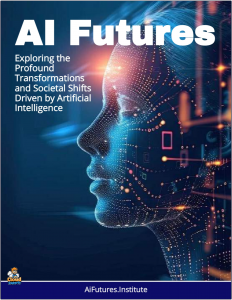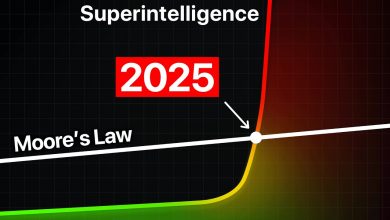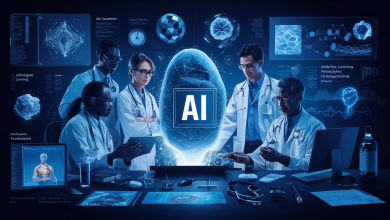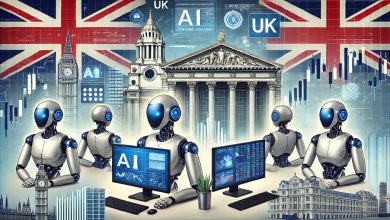The AI Future of Work: “Musk Will Get Richer, People Will Get Unemployed”
The Double-Edged Sword: Exploring AI's Transformative Impact on the Corporate Workforce and What it Means For the Future of Employment.
 The number one topic regarding the impact of AI on society today is how it will transform the job market – Will many lose their jobs to AI?
The number one topic regarding the impact of AI on society today is how it will transform the job market – Will many lose their jobs to AI?
Naturally those in the industry are keen to downplay this, keen to avoid as being seen as destroyers of livelihoods and families, but is this misleading people away from the truth of what’s coming?
There are many different views. From automating routine tasks to augmenting human decision-making, AI’s integration into workplaces has sparked intense debate. Will it trigger widespread job losses, echoing the disruptions of past industrial revolutions?
Or could it usher in a more productive, innovative era where humans thrive alongside machines? This article examines both scenarios, drawing on current trends, economic analyses, and real-world examples to provide a balanced exploration.
The Doom: AI’s Chernobyl Moment
In the feature video Geoffrey Hinton, the “Godfather of AI,” is sounding the alarm. He says that artificial intelligence could one day outsmart and overpower its creators. Hinton warns that tech giants are moving too fast, that global cooperation is needed, and that we may need a “Chernobyl moment” to take the danger seriously. From mass job losses to loss of control, Hinton says humanity’s survival depends on how we act now.
Walmart’s CEO recently issued a ‘wake up call‘ – In a series of candid statements throughout 2025, Walmart CEO Doug McMillon has emerged as one of corporate America’s most forthright voices on artificial intelligence’s disruptive potential.
Leading the world’s largest private employer—with over 2.1 million associates globally—McMillon has repeatedly emphasized that AI isn’t just coming for white-collar roles; it’s poised to transform every job, from parking lot cart collectors to C-suite executives.
His comments, delivered at events like a workforce conference in Bentonville and Harvard Business Review’s Future of Business 2025, underscore a proactive yet sobering approach: adaptation isn’t optional, and Walmart is betting big on upskilling to navigate the shift without slashing headcount.
The Pessimistic Scenario: Mass Job Displacement and Economic Upheaval
In the darker vision, AI acts as a relentless efficiency engine, displacing millions of workers in corporate sectors. Generative AI tools like large language models (LLMs) and automation platforms are already targeting white-collar roles that were once considered safe from mechanization.
Consider entry-level and mid-tier positions in fields such as data entry, customer service, legal research, and financial analysis.
A 2023 McKinsey Global Institute report estimated that by 2030, up to 800 million global jobs could be lost to automation, with 75 million in advanced economies alone. In corporate settings, this manifests vividly: AI-powered chatbots from companies like IBM Watson or Google Dialogflow handle customer inquiries 24/7, reducing the need for human agents. A 2024 study by the World Economic Forum projected that AI could automate tasks equivalent to 85 million jobs worldwide by 2025, particularly in administrative and support roles.
Real-world evidence abounds. In 2023, IBM announced it would pause hiring for 7,800 back-office jobs, citing AI’s ability to replace them via tools like its own Watsonx. Similarly, accounting firms like Deloitte and PwC have deployed AI for audit trails and tax preparation, slashing junior analyst positions. The ripple effects extend to middle management: AI analytics platforms from Salesforce or Microsoft Power BI can generate reports and forecasts faster than humans, eroding roles in business intelligence.
Economically, this could exacerbate inequality. Displaced workers—often without advanced STEM skills—face retraining barriers. A 2024 OECD report highlighted that low-skilled corporate employees in routine jobs are five times more likely to be automated out than high-skilled peers.
Unemployment spikes could strain social safety nets, fuel populism, and widen the wealth gap, as AI benefits accrue to tech-savvy corporations and executives. In extreme cases, without policy interventions like universal basic income (UBI) or robust reskilling programs, societies risk “technological unemployment” on a scale unseen since the Luddite era.
The Optimistic Scenario: Augmentation, New Opportunities, and Elevated Human Work
Flip the script, and AI emerges as a collaborator, not a conqueror. In this view, it frees humans from drudgery, boosts productivity, and creates novel jobs, mirroring how computers in the 1980s displaced typists but birthed the IT industry.
Indeed initial adoption reports have suggested that replacing humans with AI has proven a disaster.
From Tesla and Microsoft to Google, Amazon, and McDonald’s — replacing humans with AI is going horribly wrong. Companies rushed to automate jobs, only to face costly failures, service breakdowns, and public backlash.
Over 90% of AI projects deliver no measurable returns, while firms like Klarna, Duolingo, and Sports Illustrated have reversed automation after productivity and customer satisfaction plunged. The truth? The AI rush is driven more by investor hype than real results.
Historical parallels support this. The ATM, introduced in the 1970s, was feared to eliminate bank tellers; instead, teller numbers grew 50% by 2010 as branches expanded and staff shifted to relationship-building roles (per a 2015 study by James Bessen). AI could follow suit. Tools like GitHub Copilot accelerate coding by 55% (according to a 2022 Microsoft study), allowing developers to focus on creative architecture rather than boilerplate.
In marketing, AI from Adobe Sensei generates personalized campaigns, enabling strategists to innovate at higher levels.
Job creation is a key upside. The same World Economic Forum report forecasting 85 million losses also predicted 97 million new roles by 2025 in areas like AI ethics, data curation, and human-AI interaction design. Corporations are already adapting: Google and Amazon invest billions in AI, spawning positions in prompt engineering and model governance. A 2024 Gartner survey found that 80% of executives view AI as a net job creator, with roles in “augmented intelligence” surging.
Productivity gains could drive economic growth. McKinsey estimates AI could add $13 trillion to global GDP by 2030, equivalent to China’s current output. Workers benefit from upskilling: programs like Microsoft’s AI Skills Initiative have trained over 1 million people since 2023. In a positive feedback loop, liberated time fosters innovation—think R&D teams using AI simulations to shorten drug discovery from years to months, as seen with firms like Insilico Medicine.
Corporate cultures evolve too. Flexible, AI-assisted workflows reduce burnout; a 2024 Deloitte study showed hybrid AI-human teams outperform solo efforts by 30% in complex tasks. Ultimately, humans excel in empathy, ethics, and creativity—domains AI struggles with—leading to “supercharged” workforces.
Bridging the Scenarios: Factors That Tip the Balance
Reality likely blends both paths, influenced by adoption speed, regulation, and investment. Rapid, unchecked AI deployment favors displacement; thoughtful integration tilts toward augmentation.
Key determinants include:
- Reskilling Initiatives: Countries like Singapore subsidize AI training, boasting low unemployment despite automation. In contrast, the U.S. lags, with only 20% of workers reskilled per a 2024 Brookings report.
- Corporate Strategy: Firms like Accenture use AI to upskill employees internally, retaining talent. Others outsource ruthlessly.
- Policy and Ethics: Regulations mandating “human-in-the-loop” (e.g., EU AI Act) preserve jobs. Ethical AI frameworks prevent bias-amplified inequalities.
- Sector-Specific Dynamics: Manufacturing sees more losses (e.g., robotic assembly lines); creative industries gain (e.g., AI-assisted design in architecture).
Data from 2025 shows early signs of balance: U.S. Bureau of Labor Statistics reports AI-related job postings up 42% year-over-year, offsetting losses in clerical roles.
Conclusion: Navigating the AI Crossroads
AI’s impact on the corporate workforce is not predetermined—it’s a choice. The job-loss apocalypse warns of complacency, while the augmentation utopia demands proactive adaptation. Corporations must prioritize ethical AI, invest in lifelong learning, and redesign roles around human strengths. Policymakers should enact reskilling tax incentives and transitional support. For workers, embracing AI literacy is non-negotiable.
As Satya Nadella, Microsoft CEO, aptly put it: “AI is the runtime that will define this era.” Whether it runs over jobs or runs alongside them depends on us. By fostering collaboration over competition, we can harness AI to build a more prosperous, humane corporate world. The future of work isn’t about humans vs. machines—it’s humans with machines.


